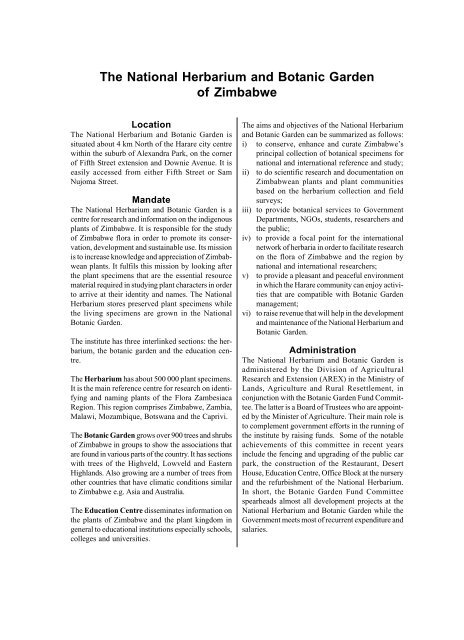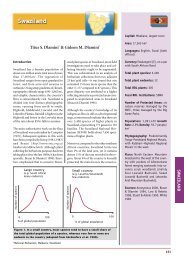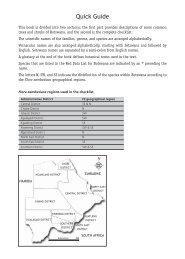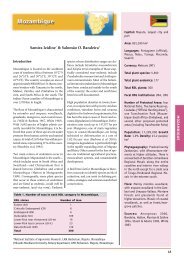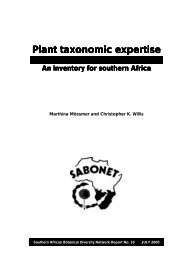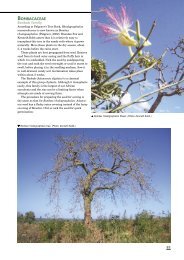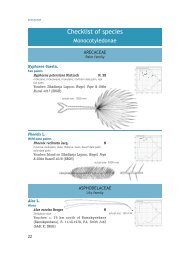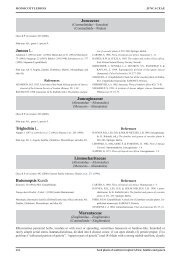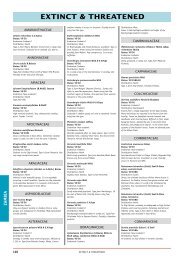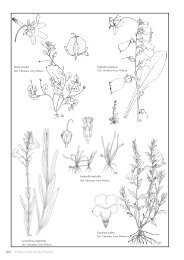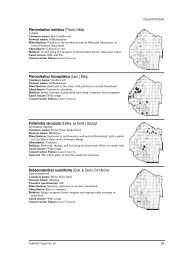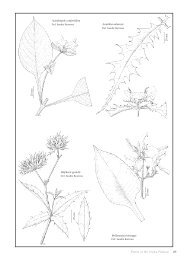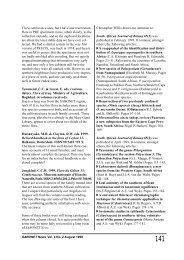Download this file - SANBI
Download this file - SANBI
Download this file - SANBI
You also want an ePaper? Increase the reach of your titles
YUMPU automatically turns print PDFs into web optimized ePapers that Google loves.
The National Herbarium and Botanic Garden<br />
of Zimbabwe<br />
Location<br />
The National Herbarium and Botanic Garden is<br />
situated about 4 km North of the Harare city centre<br />
within the suburb of Alexandra Park, on the corner<br />
of Fifth Street extension and Downie Avenue. It is<br />
easily accessed from either Fifth Street or Sam<br />
Nujoma Street.<br />
Mandate<br />
The National Herbarium and Botanic Garden is a<br />
centre for research and information on the indigenous<br />
plants of Zimbabwe. It is responsible for the study<br />
of Zimbabwe flora in order to promote its conservation,<br />
development and sustainable use. Its mission<br />
is to increase knowledge and appreciation of Zimbabwean<br />
plants. It fulfils <strong>this</strong> mission by looking after<br />
the plant specimens that are the essential resource<br />
material required in studying plant characters in order<br />
to arrive at their identity and names. The National<br />
Herbarium stores preserved plant specimens while<br />
the living specimens are grown in the National<br />
Botanic Garden.<br />
The institute has three interlinked sections: the herbarium,<br />
the botanic garden and the education centre.<br />
The Herbarium has about 500 000 plant specimens.<br />
It is the main reference centre for research on identifying<br />
and naming plants of the Flora Zambesiaca<br />
Region. This region comprises Zimbabwe, Zambia,<br />
Malawi, Mozambique, Botswana and the Caprivi.<br />
The Botanic Garden grows over 900 trees and shrubs<br />
of Zimbabwe in groups to show the associations that<br />
are found in various parts of the country. It has sections<br />
with trees of the Highveld, Lowveld and Eastern<br />
Highlands. Also growing are a number of trees from<br />
other countries that have climatic conditions similar<br />
to Zimbabwe e.g. Asia and Australia.<br />
The Education Centre disseminates information on<br />
the plants of Zimbabwe and the plant kingdom in<br />
general to educational institutions especially schools,<br />
colleges and universities.<br />
The aims and objectives of the National Herbarium<br />
and Botanic Garden can be summarized as follows:<br />
i) to conserve, enhance and curate Zimbabwe’s<br />
principal collection of botanical specimens for<br />
national and international reference and study;<br />
ii) to do scientific research and documentation on<br />
Zimbabwean plants and plant communities<br />
based on the herbarium collection and field<br />
surveys;<br />
iii) to provide botanical services to Government<br />
Departments, NGOs, students, researchers and<br />
the public;<br />
iv) to provide a focal point for the international<br />
network of herbaria in order to facilitate research<br />
on the flora of Zimbabwe and the region by<br />
national and international researchers;<br />
v) to provide a pleasant and peaceful environment<br />
in which the Harare community can enjoy activities<br />
that are compatible with Botanic Garden<br />
management;<br />
vi) to raise revenue that will help in the development<br />
and maintenance of the National Herbarium and<br />
Botanic Garden.<br />
Administration<br />
The National Herbarium and Botanic Garden is<br />
administered by the Division of Agricultural<br />
Research and Extension (AREX) in the Ministry of<br />
Lands, Agriculture and Rural Resettlement, in<br />
conjunction with the Botanic Garden Fund Committee.<br />
The latter is a Board of Trustees who are appointed<br />
by the Minister of Agriculture. Their main role is<br />
to complement government efforts in the running of<br />
the institute by raising funds. Some of the notable<br />
achievements of <strong>this</strong> committee in recent years<br />
include the fencing and upgrading of the public car<br />
park, the construction of the Restaurant, Desert<br />
House, Education Centre, Office Block at the nursery<br />
and the refurbishment of the National Herbarium.<br />
In short, the Botanic Garden Fund Committee<br />
spearheads almost all development projects at the<br />
National Herbarium and Botanic Garden while the<br />
Government meets most of recurrent expenditure and<br />
salaries.


